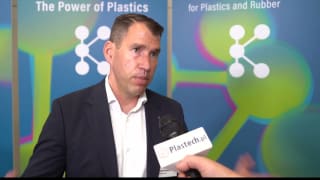The special JSW screw element is the TKD (Twist Kneading Disc), with twisted instead of conventional straight flights, which results in less pressure on the flights and achieves good dispersive mixing with low screw wear, which is an important attribute when compounding abrasive materials. The TKD elements can achieve either higher mixing capability or higher conveying capability, depending on the direction of their rotation. As mixing can take place at around 10% lower temperature than with conventional mixing elements and with less demand on the drive motor, there is corresponding 10% lower energy consumption with TKD elements.
Side feeding is usually applied to introduce fillers such as talc or carbon black or reinforcement fibers into the polymer melt in extruder mixing sections. It is here that JSW offers a SFD (Side Feed Deaerator) in its DGC (De-Gassing Cylinder) technology to exhaust volatile substances, air and moisture via a vacuum pump, so that throughput increases due to an improvement of conveying efficiency by densifying bulky powder material such as Talc, CaCO3, fine polymer powder and so on.
The effectiveness of the SFD fitted on JSW extruders has been demonstrated in trials showing 57% throughput increase when compounding 30-wt% talc filled elastomer-modified PP, 31% increase with PPO/PS blend (80wt%/20wt%) and 58% increase with 30% carbon black filled PBT.
JSW also offers the software packages for simulation of process conditions, screw design, as well as for screw element management.
Improvements made to the JSW 64-bit EXANET control system’s 15-inch color LCD control panel on both model versions have resulted in more comfortable and faster extruder operation, through for example better visibility of the touch-screen display and its icons, which enables easier triggering of specific functions. Aside from the extruder, the control system can integrate optional auxiliary equipment such as gravimetric feeders, side feeders, pelletizers. Customers can however choose to use a PLC (programmable logical control) system of their own choice, instead of the JSW EXANET system.
Other detailed improvements to the control panel include enhanced I/O (input/output) capability for greater flexibility and easier integration of the extruder with the control system, as well as upgrading of the EXANET system’s external interface by inclusion of operational conditions data management via USB connection. This is in an addition to the existing Ethernet LAN (local area network) port, with its NET 100 data logging system allowing simultaneous monitoring of up to 100 extruders.
Monitoring can take place via a web browser on desktop PCs, from which processing conditions can be adjusted via the network. Data can be directly printed, or exported as CSV format files for opening with standard office spreadsheet software, typically involving one Gigabyte of data for 300 days operation. Screen shots can also be made of the control panel display screen and exported as PNG format images that can be read with standard image programs.
JSW also offers complete turnkey compounding plants, complete vacuum and gear pumps, various types of barrels, barrel cooling systems, strand cooling baths, pelletizers, screen changers, silos, packing and palletizing equipment.
Japan Steel Works, Ltd. (represented in Europe by its Düsseldorf subsidiary) is one of the global leading manufacturers of extrusion equipment. Founded in 1907 as a steel mill, it produces injection & blow molding machines, cast and stretch film lines, reactor vessels, power plant & oil refinery components, wind turbine systems and compressors. JSW started single screw extruder production in the 1950’s, counter-rotating twin-screw extruders in 1979 and co-rotating twin-screw extruders (TEX) in 1985, now the main extruder type, produced in Hiroshima. JSW has supplied more than 2,000 TEX co rotating Twin-screw Extruders, with screw diameters ranging up to 443 mm, including a TEX400α believed to be the world's largest twin-screw devolatilization extruder.
Source: JSW
European debut of new TEX34αIII
- Pages:
- 1
- 2


